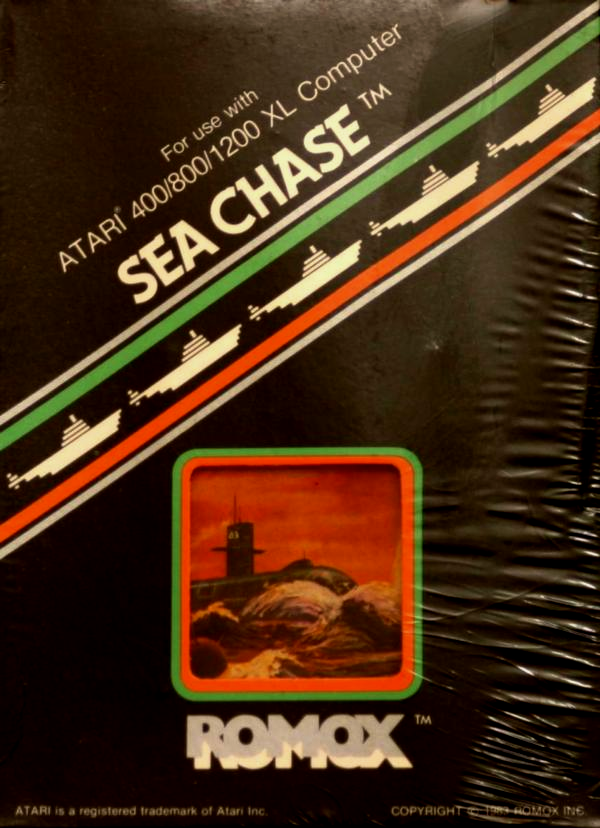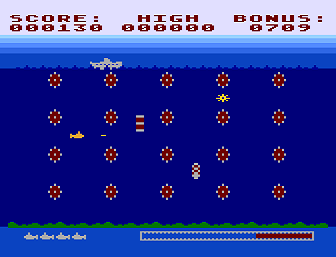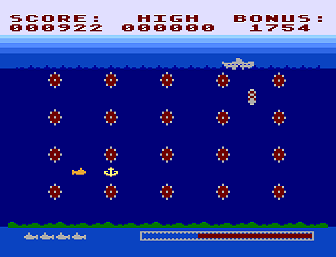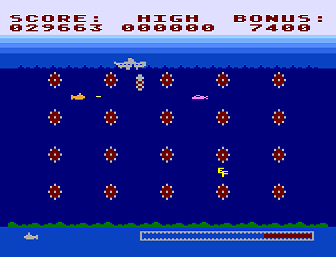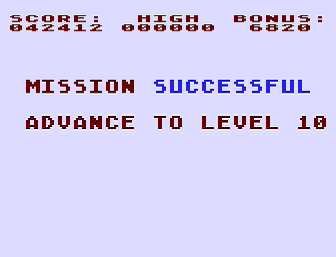SEA CHASE
Don't overlook this Atari-computer gem
When a teenaged Ed Fries took an interest in programming in the early 1980s, having grown smitten with the games in his local Bellevue, Washington arcades, he had plenty of encouragement. His father was an engineer at Boeing, his mother a punch-card programmer at Digital Equipment Corporation, manufacturer of the mainframe computers on which the first true video game, Steve Russell's Spacewar! ('62), and the first text adventure, Will Crowther's Adventure ('76), had surfaced to disrupt the work of college students all over America.
Quite a few years before Fries managed Microsoft's Xbox game group, and longer still before he designed and programmed Halo 2600 and the arcade conversion Rally-X -- both for the Atari 2600 VCS -- he wrote games on the Atari 800 that he'd received as a 1980 Christmas present, attributing them to "Eddy Fries." (He pronounces his last name "freeze." I wonder if he always thinks he's being arrested.)
His first Assembly-language game was a Spacewar! rip-off called Space Combat, which was rejected by the Atari Program Exchange on account of a few bugs. Froggie, a four-kilobyte replica of Konami and Sega / Gremlin's Frogger coin-op, was circulated among dial-up bulletin boards until a multi-platform software company in Campbell, California called Romox took notice and hired him.
His first job at long distance was to change his own Froggie graphics. The Princess and the Frog (Romox's idea) accordingly dodged litigation. He went on to create a couple of eight-kilobyte games for the company while earning his BS in Computer Science at the Institute of Mining and Technology, right here in New Mexico. Sea Chase, released on cartridge in '83, was the most fun and certainly the most original.
It's a straightforward but highly compelling game set amid a strikingly orderly five-by-four array of underwater mines, each of which will blow up the player's speedy submarine upon contact, even while mysteriously remaining intact itself (or getting replaced right away, perhaps).
The sub is yellow, just like the one in every applicable game that I can think of. Of course, all that come to mind at the moment are two Atari 2600 games: Activision's superb Seaquest and Data Age's atypically top-shelf Bermuda Triangle. I'm certain that there are plenty of others, though. There must have been a lot of fellow Beatles aficionados writing software in the '80s.
Your chief rival is hiding gutlessly inside a destroyer, which drifts back and forth along the surface at the top of the playfield. Turn it into a shipwreck to beat the current level. What do you mean, "That sounds easy"? Don't get cocky with me, pal. It just so happens that you're controlling a very rare kind of sub that can't break the surface itself; the destroyer can only be taken out from below. Before that can happen, you've got to get your extremely wrinkled hands on a missile. You'll be able to launch that upward, whereas your normal projectiles are strictly horizontal.
The destroyer constantly drops lethal vacuum-cleaner hoses, which essentially serve as really dumb bad guys. They sink slowly between mine columns before hitting the seabed or detonating at random. Be careful; their brief explosions are deadly, too. What? Well, call them "depth charges," then. Whatever floats your boat. They look like vacuum-cleaner hoses to me -- or accordions, as they each expand and contract like no depth charge I've ever seen.
Whatever you want them to be, the important thing is that they can be blasted, thanks to your sub's torpedo cannon. It's great to be able to clear them out of the way, as opposed to coping with them along with the other navigational hazards. Besides, it's important in life to take some time out for destruction every so often. Only one of your torpedoes can beautify the screen at a time, but you'll fire continuously if you hold the button down. The mines will stop your shots, but the flashing treasures won't.
Speaking of those, they appear individually in random locations, and your collisions remove them and bump up the amount of air shown in the gauge beneath the playfield. They look like luminous sofa doilies at first, but they change from level to level, resetting after the eighth. Yes: It's one of those "Survive to see the next graphic" games that we '80s kids are suckers for. As you can clearly see, the Level 2 treasure is an anchor. Or possibly a discarded hood ornament.
When you've acquired eleven treasures, the missile shows up instead of a twelfth. You've apparently been saving up for it. This explains why you've been collecting valuables in the first place. Take the missile, take aim and push the button, taking care to avoid hitting one of the mines or "depth charges" (fine, fine) instead of the destroyer, as you'll only get one shot. If you miss, you won't lose a sub or any points, but you'll have to repeat the level. Happily, this fresh start isn't required when your sub has actually been destroyed. Being made to posthumously tackle the present level / wave / stage / round / parade / bath / etc. from scratch will greatly diminish most any game for me.
When the missile makes contact with the destroyer, there's an explosion (there had damn well better be, after all of that) and you get to watch your adversary sink beneath the waves. It's crucial at this point to yell at the screen: "Hah! I didn't die, and you did!" Then it's on to the next level, the next type of treasure and, needless to say, a higher degree of difficulty. The game doesn't truly get tricky until Level 3, on which the destroyer begins to deploy pink, armed sharks. These move and fire indiscriminately, rather than hunting your sub. Fries -- or whoever wrote the instructions that are found on the back of the box -- thought of them as Sea Probes, but they sure dash around swiftly for vehicles with engines and rudders and all.
You only have to contend with one shark at first, but the likelihood of two showing up increases as the levels progress. Shooting one of these bothersome things involves chance just as much as aim, because they bounce up and down between their rapid movements from position to position. Maintain a distance when you can; this will improve your chances of shirking their very fast shots. Simply fire in the general direction of the nearest shark and return to collecting treasures, as its erratic movement makes a distant bull's-eye just as possible as a close-range one. You'll know when you've hit a far-off shark, as it will blow apart in a very cool, vertically protracted manner. It reminds me of the Williams arcade game Robotron: 2084.
Another good strategy is to shun the frequent game-play practice of surveying the whole screen whenever possible. Instead, keep a keen eye on your sub, relying on peripheral vision when you take shots. Because of your slight momentum, it's very easy to glide right into a mine when you're not paying close attention. Take into account that the trigger-happy sharks -- which might actually be spitting salmon, given their pinkness -- join the other things in obstructing your lone missile. Thankfully, they're wiped out by depth-charge contact just as readily as your sub is.
Be especially cautious when you have to rise near the destroyer to grab a treasure, as it will dispatch a charge wherever an old one isn't still sinking. It's best to wait for the destroyer to pass overhead, remembering to give yourself enough room to torpedo the likely forthcoming charge. Once you've got the missile, launch it from left or right of center between mine columns; each charge is dropped precisely down the middle.
I spy an Easter egg in plain sight! Anyway, the air-tank gauge obviously serves as a timer. This merely eggs you onward (an egg timer?), forever encouraging you to head for the next treasure. It doesn't represent much of a threat. Not at first, anyway. By Level 9, your air will be depleting so quickly that you might find yourself wishing for a pit-stop bonus level on which your leak can be repaired.
Fries seems to have taken this unreasonable route in lieu of devising further challenges (or squeezing them into memory, perchance). Unless you get lucky and the treasures materialize very near to one another, your sub will either run out of air and slowly, comically plummet to the grimy floor -- you've presumably passed out at the helm -- or run into something as you hasten it toward a treasure.
Don't sweat it, though. You probably won't make it that far. Hardly anyone's as good at video games as I am, and you don't have to be to enjoy this one. It's surely enough that you're somehow able to convert treasures into oxygen. What's more, you start with a generous fleet of five subs, and a back-up arrives when you reach 10,000 points. It's the only one that you receive, however -- you don't get one for every 10,000 -- and this sort of thing is puzzling in any home game, as quarter-sucking methods are unnecessary. But then, I despise any business decision that interferes with artistic decisions, arcade game-related or otherwise. I've typed this before and I'll probably type it again: The two major banes of the entire video-game industry have always been executives and deadlines.
The bonus counter to the upper right decreases independently of your remaining air, surviving subs and in fact everything except when each level begins. It starts a thousand points higher every time you advance, and whatever's left when you vanquish the destroyer and its renegade salmon fishermen is added to your score just before the next level commences.
The sea that you're darting around in isn't exactly a vast one. The sub can horizontally wrap around the screen, even though its projectiles can't. Nor can the annoying baddies and their shots, and this detail augments your available evasive maneuvers. (Now that I think about it, this could just be a large swimming pool. If so, the owner needs to start cleaning better.)
I'll advance when I'm good and ready, Mister Order-Giver. Shouldn't that happen automatically, though? Do I actually have to learn 6502 Assembly, infiltrate the program code and manually increment the level number if I want to keep going? Oh, wait. Never mind.
Sea Chase feels good to play and becomes quite engrossing after a bit of practice. The sub's gradual acceleration and minor momentum initially come across as hassles, but they ultimately add to the game's overall visceral pleasure. You'll soon find yourself swooping about and lunging between mines in a most fluid, even graceful manner -- not to mention cheerfully slaughtering marine life.
When I've lost a "life" during any game, I like to think that my enemies are shocked and dismayed by my instant reappearance. "He's back? Curses! [True villains always say "curses" instead of actually cursing.] We'll never get rid of this guy! What? No, I don't think that he only came back to clean the pool!"
